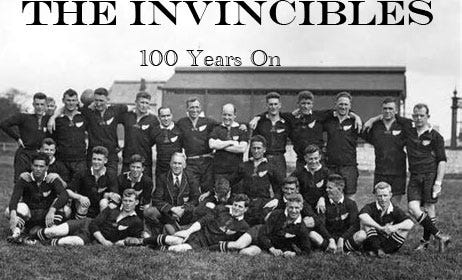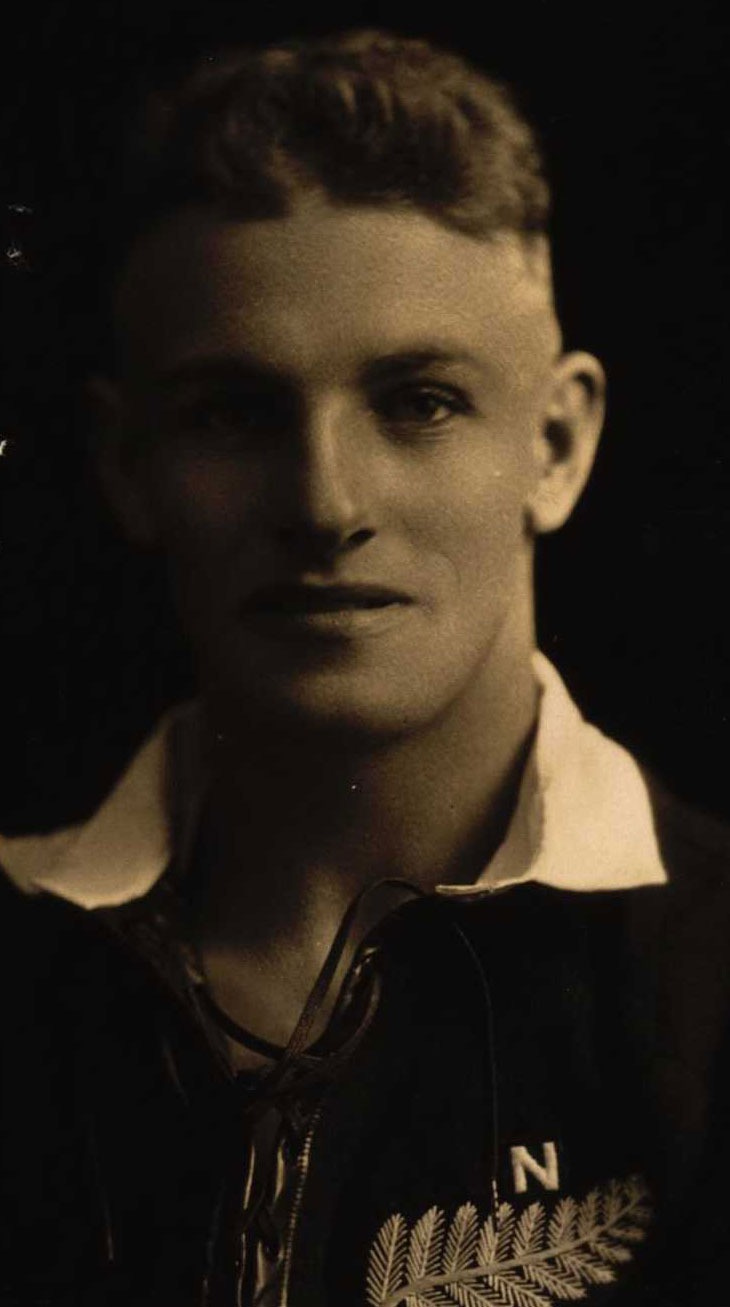Bert Cooke was one of the first players to make his name on the 1924-25 All Blacks tour with some outstanding attacking play, but it almost didn't happen.
When the All Blacks were sailing to Britain, they stopped over in Panama, and it was there Cooke learned his mother had died while he was sailing across the Pacific. His immediate reaction as the eldest in the family was to return home to look after his six siblings, who now had neither of their parents.
Knowing what an impact he could have on the success of the tour, his teammates convinced him to stay. Only later did he learn that Quentin Donald, whose family were well-placed among the Wairarapa farming gentry, cabled home and requested 100 pounds be passed on to Cooke's brothers and sisters.
Bert Cooke (Archives New Zealand Reference: ACGO 8333 IA1 1349 15/11/17721)
Given his concern for his family, it only makes the achievements of the 10st 4lb (65.32kgs), 5ft 9in(1.75m) second five-eighths/centre Cooke all the more impressive.
Cooke hadn't played for the All Blacks before his selection in 1924. At the start of 1923, he only hoped to enjoy another championship success with his Grafton third-grade side. A year earlier, after his third-grade team won the Auckland title, Cooke was called into the Grafton Junior side for their final games with whom he shared another Auckland title. As a result of that success, he was called to play a few games with the seniors, where he first played alongside future All Blacks teammate Mark Nicholls, who played that season in Auckland. That resulted in him being selected for the club seniors, against his wishes, in 1923. He even attempted to get a regrade but wasn't successful.
Instead, he played every game for Auckland that year and was a reserve for the All Blacks in their final 'Test' with New South Wales. The last Auckland game of the season was a return encounter against the great Hawke's Bay Ranfurly Shield side, which beat Auckland in a challenge earlier in the season 20-5. The return game in Auckland was keenly awaited, and the home team was successful 17-9. Cooke rated the game as one of the hardest he played during his career.
I got a kick in the spine, but did not go off. About 10 o'clock that night my legs went numb. I was taken off to hospital and was there a fortnight. A doctor told me I would never play football again, a very nice thought on which to end the season.[1]
However, Cooke recovered, and making the team for the tour to Britain was a big incentive.
Scoring three tries for Auckland in its annual game with Waikato got him off to a good start just before the trial matches were played. But, if there was one game that confirmed his selection for the tour, it was the North-South game of that year.
He was a genius, and his play an inspiration. In addition he had a sprinter to back him up, and it was largely the manner in which Hart succeeded in this, that gained him selection. Hart scored three tries and 'potted' a goal from the sideline, and the South Island were hopelessly beaten by the combination of these two.[2]
Cooke's ability to feed players into try-scoring positions made him an outstanding success at centre, where he played eight games, including the Tests against Wales and England. Coupled with that was his ability on the break.
One recollects his sudden and quick break through, his snappy run, his timely and useful short punt. He passes well on all occasions, and gives those who back him up every opportunity. Without a doubt, however, his greatest attributes were his dash and quickness off the mark, added, of course, to quick thinking, or rather sharp instinct.[3]
Cooke's summation of the way he liked to play was,
There's nothing to touch the sheer job of beating a man by outwitting him. I tried to do something different every time I laid my hands on the ball. The very essence of back play is quickness off the mark, and to perplex and outplay your opponent.[4]
Cooke said his play was instinctive and believed it was natural to him.
Karl Ifwersen once said to me: 'Just play your own football, Bert, and if anyone tells you what to do just let it go in one ear and out the other.' I simply knew that the hard I could get a bloke to run at me, the easier I could beat him. Mind you, I was lucky to be playing with men like Ifwersen and Mark Nicholls.[5]
He scored 19 tries on the tour's British, Irish and French leg, one fewer than the top try scorer Gus Hart, but, in modern parlance, he would have provided many assists to all who played outside him.
Cooke's role in the team's attack was pivotal, as evidenced by the 23 games he played during that part of the tour. His strategic importance was further highlighted by his ability to withstand fierce knocks and continue to influence the game.
Being of Welsh parentage, Cooke was closely watched and appreciated during the Wales club games, especially in the all-important Test match. One Welsh writer, Old Stager, said Cooke was the hero for his side and was always a source of danger to Wales because of the speed with which he darted into play and the resolution he displayed in going for his objective.
If any single player has cause for complaint at the ill-luck which persistently shadowed him it is he, for it is a most remarkable thing that although he was by far the best attacker in the sides and did more work of a high class in that realm than all the other players put together, not a single one of his efforts was crowned with a full measure of success.
Time after time in the opening half Welshmen shivered and shuddered as they watched him slithering his way through the defence, bringing into operation at their proper moments the side-step, the swerve, or the straight dash ahead, but somehow or another a last-minute tackle, a dropped ball or a forward pass turned up at the crucial moment to deprive him of all that he had seemed to have earned.[6]
Because of backline issues the tourists had, it was decided to move the five-eighths, Mark Nicholls and Cooke, out a position and start with Neil McGregor, an outstanding performer on the tour, at first five-eighths to give the team the solidity it required.
Cooke told the Hawke's Bay Tribune Neil McGregor was the best five-eighth he played beside.
McGregor uses his head all the time, and can be depended upon always. He will stop anything.[7]
Cooke returned to New Zealand a hero among heroes and began a peripatetic phase of his life that saw him play for Hawke's Bay, Wairarapa and Wellington before he switched to rugby league amid the Depression in 1932.
When he announced what proved a short-lived early retirement in 1926, the Hawke's Bay Tribune said,
No other man in the Dominion has Cooke's ability of kicking accurately and powerfully when going at top. He is a man who was made for football, that rare person, the born Rugby player. His record shows that.[8]
He has the build of a boxer, with a deep chest that speaks of tons of reserve energy; reserves are what a footballer plays on.[9]
However, Cooke popped up in Masterton and resumed his career playing for Wairarapa and helping it win the Ranfurly Shield. Famously, when Wairarapa lost the Shield to Southland in the 100th game for the trophy, so unlikely was a Southland win that the Shield had been left in Cooke's Mercer's shop in Masterton, that necessitated a quick drive from Carterton, where the game was played, to bring it down the road to be presented to the winners. In 1930, he moved to Wellington, and was a member of the Wellington team that took the Shield from Southland.
Before then, however, Cooke announced he would not be available for New Zealand's tour to South Africa in 1928.
I did not want to go, and said so. I had no wish to leave my business and domestic responsibilities. However, just before the final trial, Possibles v Probables, on October 8 1927, after the 16 certainties had already been announced, I let myself be talked into it'. Mr Stan Dean's persuasiveness was chiefly responsible. He was very anxious for me to go, and I appreciated the compliment. I was given to understand beforehand that an appearance in the final trial would be a mere formality, and I could count on being selected.
Fred Lucas had also been persuaded to change his mind about going to South Africa, and he too played in only the final trial. We both played for the Possibles, who won by 44 to 9, and both duly got places in the team. However, I was not really happy about altering my [original] decision, and the following February I was reluctantly compelled to tell the New Zealand Union that I could not go.[10]
Cooke also played in the home series against the touring Great Britain (Lions) team in 1930 but retired from rugby at the end of the four-Test series. In his first-class career of 131 games, he scored 119 tries, good enough for him to sit 19th on the all-time try-scoring list.[11] He returned to play rugby league in 1932, winning a Kiwis cap and making five Test appearances. He was reinstated to rugby in the late-1930s.
Next issue: Newport sets a trap.
[1] Bert Cooke, 'My Football Memories,' The New Zealand Observer, July 30, 1936
[2] AH Carman, Daily Telegraph (Napier), 21 July 1927
[3] ibid
[4] Bert Cooke, Obituary, Rugby News, Auckland, 1977
[5] Bert Cooke, interviewed by Max Smith, Auckland Star, 6 July 1963
[6] Old Stager, South Wales Echo, 1 December 1924
[7] ibid
[8] Hawke's Bay Tribune, 16 October 1926
[9] ibid
[10] Cooke, Memories, ibid, 20 August 1936
[11] The list of New Zealand try scorers is: John Kirwan 199 (268 games), Terry Wright 177 (217), Doug Howlett 173 (240), Bernie Fraser 171 (200), Christian Cullen 164 (233), Zinzan Brooke 161 (311), Tana Umaga 156 (329), Jeff Wilson 151 (233), Julian Savea 147 (291)+, Ron Jarden 145 (134), Roger Randle 141 (189), Bryan Williams 137 (269), Kel Tremain 136 (268), Paul Cooke 133 (195), Caleb Ralph 133 (306), Jonah Lomu 126 (203), Mike Clamp 123 (139), Ma'a Nonu 120 (348), Bert Cooke 119 (131), Sitiveni Sivivatu 116 (187). Note: modern databases appear to include Savea's tries for NZ U-20 as first-class. His figures are as of Oct. 8 2024




